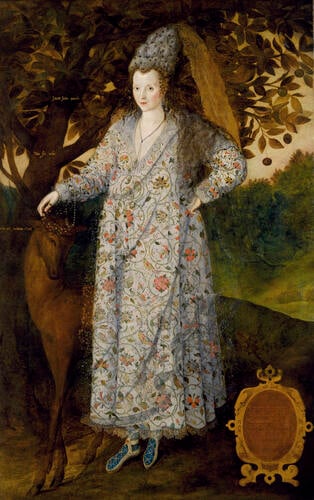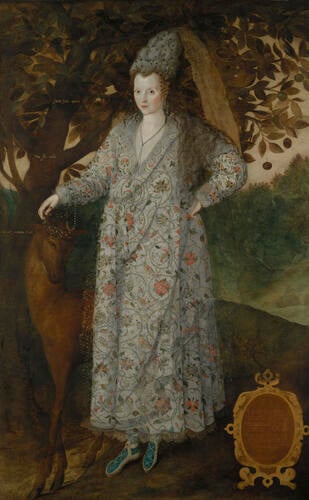-
1 of 253523 objects
Portrait of an Unknown Woman c.1590-1600
Oil on canvas | 216.2 x 135.5 cm (support, canvas/panel/stretcher external) | RCIN 406024
-
Although the identification of the sitter remains unknown (it was once thought to be a portrait of Elizabeth I), the attribution to Marcus Gheeraerts the Younger has been resolved on the basis of the elaborate inscriptions. A similar type of calligraphy is found on a number of works all by the same hand dating from the 1590s. These accord with the style of painting and the inscriptions on signed and dated portraits by the artist from the later part of his career.
Portrait of a Woman is a typical example of Elizabethan allegorical portraiture. The symbolism, which is clearly complex, embraces the tree, the stag, the flowers, even the birds and the sitter’s costume. The longhaired figure wears pearls attached to her wrist and a pendant with a miniature around her neck. The sitter may be wearing a costume designed for a court masque and her headdress is derived from J. Boissard’s Virgo Persica in his Habitus variarum orbus gentium, (1581). The general mood of the portrait is one of melancholy.
The painting may be related to the Ditchley portrait of Elizabeth I (London, National Portrait Gallery) and to the Portrait of Thomas Lee (London, Tate Britain). Thus there may be some connection with these three portraits and the entertainment given by Sir Henry Lee, the Queen’s Master of the Armouries and Champion of the Tilt, on the occasion of the Queen’s visit to Ditchley in 1592.
The portrait is recorded by the eighteenth-century antiquarian, George Vertue, as once having the royal cypher of Charles I on the back of that canvas, indicating that it formed part of his collection.
Inscribed twice on the tree: Iniusti Justa querela [A just complaint of injustice] and Mea sic mihi [Thus to me my...[?tree was the only hope]]; inscribed by the stag’s head: Dolor est medicina [e] d[o]lori [Grief is medicine for grief]
In a cartouche lower right is the following sonnet:
The restless swallow fits my restless minde,
In still revivinge still renewinge wronges;
her Just complaintes of cruelty unkinde,
are all the Musique, that of my life prolongs.
With pensive thoughtes my weeping Stagg I crowne
whose Melancholy teares my cares Expresse;
her Teares in silence, and my sighes unknowne
are all the physicke that my harmes redresse.
My onely hope was in this goodly tree,
which I did plant in love bringe up in care:
but all in vanie [sic], for now to late I see
the shales be mine, the kernels others are.
My Musique may be plaints, my physique teares
If this be all the fruite my love tree beares.Provenance
In Charles I's collection, recorded in the Queen's Gallery at Greenwich in 1639 (no 17); sold from here for £6 to Murray and others 23 October 1651 (no 131); not immediately recovered at the Restoration but re-acquired by Queen Anne and listed as an overdoor in the Blue Passage Room at St James's Palace in 1710. By 1818 it was described as Queen Elizabeth by Federico Zuccaro in the Queen's Gallery at Kensington Palace (no 259), where it appears in Pyne's illustrated Royal Residences of 1819 (RCIN 922155).
-
Creator(s)
Acquirer(s)
-
Medium and techniques
Oil on canvas
Measurements
216.2 x 135.5 cm (support, canvas/panel/stretcher external)
243.0 x 161.9 x 11.0 cm (frame, external)
Other number(s)
Alternative title(s)
Portrait of a woman
Elizabeth I (1533-1603), previously identified as
Anne Vavasour (fl 1580s)?
Lady Arabella Stuart (1575-1615), previously identified as
Lady Shirley (1593-?), wife of Sir Robert Shirley, previously identified as
Lady in Fancy Dress

